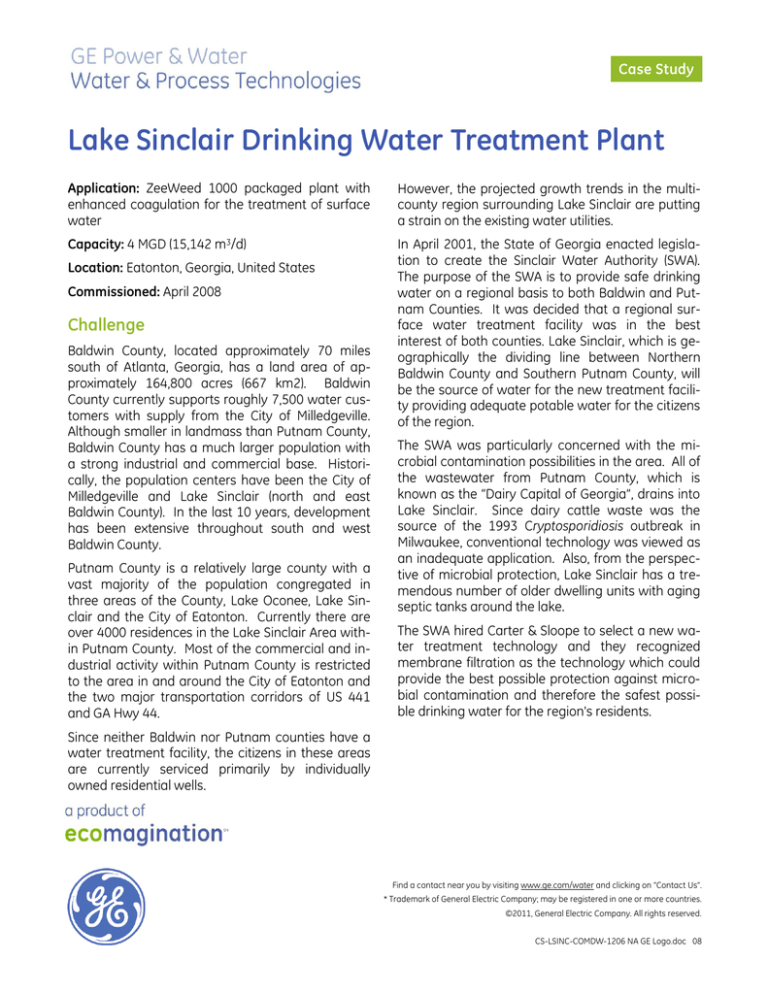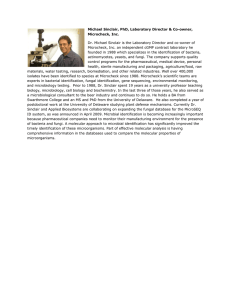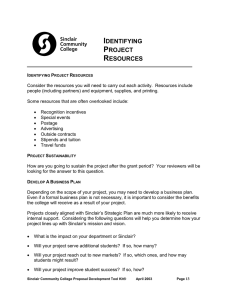
Case Study
Lake Sinclair Drinking Water Treatment Plant
Application: ZeeWeed 1000 packaged plant with
enhanced coagulation for the treatment of surface
water
However, the projected growth trends in the multicounty region surrounding Lake Sinclair are putting
a strain on the existing water utilities.
Capacity: 4 MGD (15,142 m3/d)
In April 2001, the State of Georgia enacted legislation to create the Sinclair Water Authority (SWA).
The purpose of the SWA is to provide safe drinking
water on a regional basis to both Baldwin and Putnam Counties. It was decided that a regional surface water treatment facility was in the best
interest of both counties. Lake Sinclair, which is geographically the dividing line between Northern
Baldwin County and Southern Putnam County, will
be the source of water for the new treatment facility providing adequate potable water for the citizens
of the region.
Location: Eatonton, Georgia, United States
Commissioned: April 2008
Challenge
Baldwin County, located approximately 70 miles
south of Atlanta, Georgia, has a land area of approximately 164,800 acres (667 km2). Baldwin
County currently supports roughly 7,500 water customers with supply from the City of Milledgeville.
Although smaller in landmass than Putnam County,
Baldwin County has a much larger population with
a strong industrial and commercial base. Historically, the population centers have been the City of
Milledgeville and Lake Sinclair (north and east
Baldwin County). In the last 10 years, development
has been extensive throughout south and west
Baldwin County.
Putnam County is a relatively large county with a
vast majority of the population congregated in
three areas of the County, Lake Oconee, Lake Sinclair and the City of Eatonton. Currently there are
over 4000 residences in the Lake Sinclair Area within Putnam County. Most of the commercial and industrial activity within Putnam County is restricted
to the area in and around the City of Eatonton and
the two major transportation corridors of US 441
and GA Hwy 44.
The SWA was particularly concerned with the microbial contamination possibilities in the area. All of
the wastewater from Putnam County, which is
known as the “Dairy Capital of Georgia”, drains into
Lake Sinclair. Since dairy cattle waste was the
source of the 1993 Cryptosporidiosis outbreak in
Milwaukee, conventional technology was viewed as
an inadequate application. Also, from the perspective of microbial protection, Lake Sinclair has a tremendous number of older dwelling units with aging
septic tanks around the lake.
The SWA hired Carter & Sloope to select a new water treatment technology and they recognized
membrane filtration as the technology which could
provide the best possible protection against microbial contamination and therefore the safest possible drinking water for the region's residents.
Since neither Baldwin nor Putnam counties have a
water treatment facility, the citizens in these areas
are currently serviced primarily by individually
owned residential wells.
Find a contact near you by visiting www.ge.com/water and clicking on “Contact Us”.
* Trademark of General Electric Company; may be registered in one or more countries.
©2011, General Electric Company. All rights reserved.
CS-LSINC-COMDW-1206 NA GE Logo.doc 08
Solution
A pilot study was conducted to select the best
membrane system that could produce treated water meeting or exceeding state and federal drinking
water guidelines with minimal operator attention.
Several membrane manufacturers systems were
piloted. GE Z-BOX* packaged water treatment plant
was selected based on pilot study results which
showed excellent treated water quality in terms of
pathogen and virus removal, turbidity, manganese
and iron removal, TOC removal and THM and HAA
formation potential. In addition, the system was
able to run with less than two hours of operator attention per day.
Process Overview
The SWA had decided on a multiple barrier approach for both microbial and chemical contaminant concerns. The primary barrier for microbial
concerns is the membrane filtration process.
The Lake Sinclair Z-BOX packaged plant incorporates ZeeWeed* 1000 ultrafiltration membranes.
With a nominal pore size of 0.02µm, ZeeWeed 1000
membranes act as a physical barrier to virtually all
suspended particles, and can consistently provide
4-log removal (99.99%) of Giardia, Cryptosporidium,
bacteria and viruses. These removal rates ensure
that the water from the treatment plant will meet
state and federal drinking water guidelines, and
protect residents from microbial contamination.
The initial capacity of the water treatment plant is
to produce 4 million gallons (15,142 m3) over 16
hours, in one day. The build-out capacity is to produce 6 million gallons (22,712 m3) over 18 hours, in
one day. The ultimate capacity of the water treatment plant is to produce 8 million gallons (30,283
m3) over 21 hours, in one day.
Page 2
The proposed raw water intake will draw water
from the Oconee River arm of Lake Sinclair. There
will be chlorine dioxide injection at the raw water
pump station to provide the first barrier against waterborne pathogens. On a seasonal basis, potassium permanganate will also be dosed at the raw
water pump station to oxidize iron and manganese.
The raw water will then flow through a conventional
coagulation/flocculation process, which will help
flocculate organic particles. Alum will be used as
the coagulant and powdered activated carbon
(PAC) may be used seasonally to help in the removal
of smaller organic material not easily removed by
conventional coagulation process.
After membrane filtration, the treated water will be
treated with MIOX (Mixed Oxidant) as a second
source of disinfection, lime for the adjustment of pH,
a polyphosphate for corrosion control, and fluoride
for health benefits. Process waste from all processes at the water treatment plant will be directed to
one of two alum lagoons. The settled water from
the lagoons will be discharged back to Lake Sinclair.
Upon completion, the Lake Sinclair Drinking Water
Treatment system is the first package ZeeWeed
1000 plant in the state of Georgia.
Typical Treated Water Results
Raw Water
Treated Water
Turbidity (NTU)
<2
< 0.1
Giardia
(per 100L)
N/A
> 4 log removal
Cryptosporidium
(per 100L)
N/A
> 4 log removal
Viruses
N/A
> 3.5 log removal
Case Study



